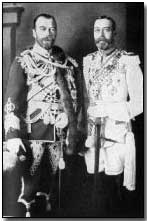Who's Who - Tsar Nicholas II
 Tsar Nicholas II (1868-1918) - Russia's
last emperor - was born on 18 May 1868 in Tsarskoe Selo.
Tsar Nicholas II (1868-1918) - Russia's
last emperor - was born on 18 May 1868 in Tsarskoe Selo.
Nicholas succeeded his father's throne, Alexander III, when the later died from liver disease on 20 October 1894. Nicholas was 26.
That same year Nicholas married Princess Alexandra of Hesse-Darmstadt, the grand-daughter of Queen Victoria. Alexandra was instrumental in convincing Nicholas to resist ever-growing calls for increased democracy within Russia. Alexandra was a firm believer in the autocratic principle. Nicholas required little persuasion: as a nationalist he decried those who favoured western style democracy.
Alexandra was unpopular with the Russian elite, more so as evidence emerged of her increasing influence over her husband. Her reliance upon Grigory Rasputin in determining Russian policy angered many, ultimately leading to Rasputin's assassination.
Defeat in the war with Japan of 1904-5 seriously damaged Russian prestige - and with it the esteem of the monarchy. Japan had launched a surprise attack on the Russian fleet based at Port Arthur; throughout the war the Russian navy was found wanting, although the army fared better in repulsing Japanese troops in Manchuria.
At the same time as Russia faced war with Japan, there was increasing industrial unrest at home. Workers who faced long hours and poor conditions increasingly formed protests.
In 1904 110,000 workers in St Petersburg striked for four days in protest at the declining value of wages in real terms. Georgi Gapon, of the Assembly of Russian Workers, appealed to Nicholas for help in reducing working hours and improving pay and conditions. A consequent march on the Winter Palace was greeted by armed Cossacks: over 100 protestors were killed and many more wounded.
'Bloody Sunday', as it became known, sparked the 1905 Revolution, whereby strikes spread around the country and mutiny throughout the army and navy. Leon Trotsky founded the St Petersburg Soviet in October, with 50 more being established over the next month in the rest of the country.
In response to such wide-scale protest, and under the advice of close advisers, the Tsar published the 'October Manifesto', which granted freedom of conscience, speech, meeting and association, and the end of imprisonment without trial. In addition, no new law would become effective without the approval of the Duma, a consultative body.
The October Manifesto did not satisfy Trotsky (who with his supporters was subsequently arrested for his actions taken in protest) but did take the sting out of the crisis that had formed.
Although the Duma had been viewed as a toothless advisory body, at its first meeting in May 1906 it made demands for the release of political prisoners, for trade union rights and land reform. In rejecting these demands Nicholas promptly dissolved the Duma.
Later that year Nicholas replaced the moderate chief minister Sergi Witte with the more conservative Peter Stolypin. Stolypin attempted to balance the demands of both liberal and conservative factions in the country. He was ultimately unsuccessful: he was assassinated in 1911 by a member of the Socialist Revolutionary Party at the Kiev Opera House.
With Germany's decision to enter into the Triple Alliance system with Austria-Hungary and Italy - whereby each of the three nations agreed to come to the other's aid in the event of attack by either France or Russia - Russia naturally saw Germany as its main potential enemy; this despite Nicholas's position as the cousin of German Kaiser Wilhelm II.
Consequently Russia entered into an alliance with Britain and France, the 'Triple Entente'. When war was declared by Germany with France in August 1914, Russia came into the war on France's side.
Russian industrial unrest had continued into the first half of 1914. Up to half of the entire workforce are estimated to have striked that year. The war temporarily brought an effective end to industrial unrest however, although it later returned. The war also brought Nicholas political benefits; the establishment united behind him in the conduct of the war.
Dissatisfied with the army's conduct of the war, Nicholas took personal command in September 1915. The Russian army were fighting on the Eastern Front and its ongoing lack of success was causing dissension at home. Unfortunately, now operating under Nicholas II's supreme command, its continued failure reflected directly upon the Tsar himself rather than the army command. Nicholas's popularity dwindled.
By late 1916 royalists within the Duma warned the Tsar that revolution was imminent; even so, Nicholas refused to sanction further constitutional reform. During the so-called 'February Revolution' in 1917, which he misinterpreted as a minor uprising, his routine suppression orders to the Petrograd garrison sparked its mutiny on 10 March.
Nicholas II was persuaded to abdicate on 15 March 1917 under the recommendation of the Russian Army High Command. In search of exile elsewhere, Lloyd George offered a haven in Britain, only for the offer to be withdrawn under the direction of King George V, who did not wish to be associated with his autocratic cousin at this point: a controversial decision.
Moved to the Siberian city of Ekaterinburg by the Bolsheviks, Nicholas and his family were executed on the night of 16/17 July 1918.
Click here to view footage of the Tsar and Tsarina filmed prior to the outbreak of war in 1914; click here to view the Tsar's imperial declaration of war in St. Petersburg.
Stormtroopers comprised specially trained German assault troops used in 1918.
- Did you know?
